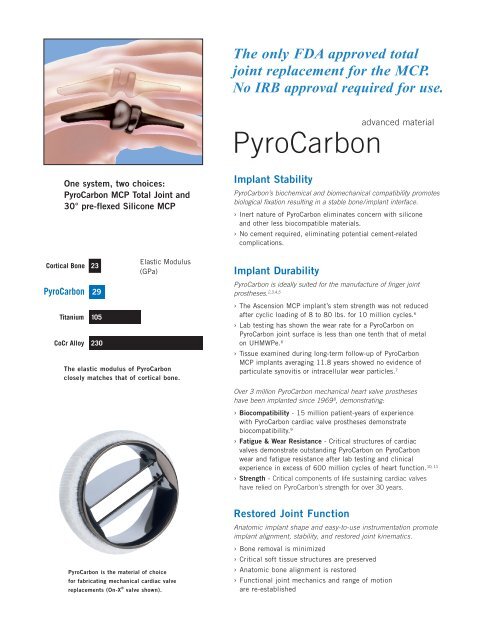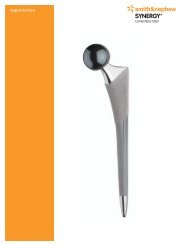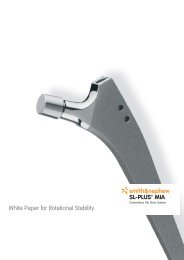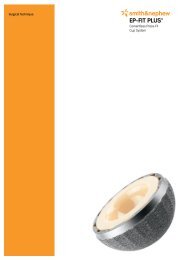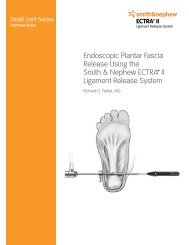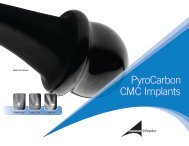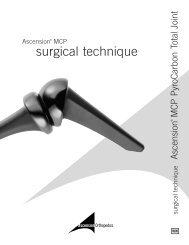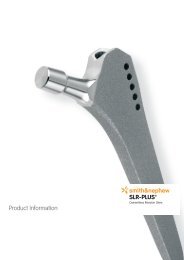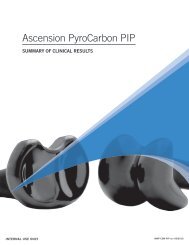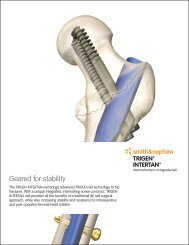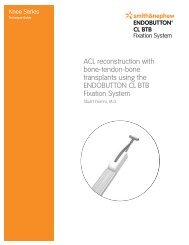Ascension® PyroCarbon MCP Total Joint emitiesâ¢
Ascension® PyroCarbon MCP Total Joint emitiesâ¢
Ascension® PyroCarbon MCP Total Joint emitiesâ¢
You also want an ePaper? Increase the reach of your titles
YUMPU automatically turns print PDFs into web optimized ePapers that Google loves.
The only FDA approved total<br />
joint replacement for the <strong>MCP</strong>.<br />
No IRB approval required for use.<br />
advanced material<br />
<strong>PyroCarbon</strong><br />
One system, two choices:<br />
<strong>PyroCarbon</strong> <strong>MCP</strong> <strong>Total</strong> <strong>Joint</strong> and<br />
30° pre-flexed Silicone <strong>MCP</strong><br />
Cortical Bone<br />
<strong>PyroCarbon</strong><br />
Titanium<br />
CoCr Alloy<br />
23<br />
29<br />
105<br />
230<br />
Elastic Modulus<br />
(GPa)<br />
The elastic modulus of <strong>PyroCarbon</strong><br />
closely matches that of cortical bone.<br />
Implant Stability<br />
<strong>PyroCarbon</strong>’s biochemical and biomechanical compatibility promotes<br />
biological fixation resulting in a stable bone/implant interface.<br />
› Inert nature of <strong>PyroCarbon</strong> eliminates concern with silicone<br />
and other less biocompatible materials.<br />
› No cement required, eliminating potential cement-related<br />
complications.<br />
Implant Durability<br />
<strong>PyroCarbon</strong> is ideally suited for the manufacture of finger joint<br />
prostheses. 2,3,4,5<br />
› The Ascension <strong>MCP</strong> implant’s stem strength was not reduced<br />
after cyclic loading of 8 to 80 lbs. for 10 million cycles. 6<br />
› Lab testing has shown the wear rate for a <strong>PyroCarbon</strong> on<br />
<strong>PyroCarbon</strong> joint surface is less than one tenth that of metal<br />
on UHMWPe. 6<br />
› Tissue examined during long-term follow-up of <strong>PyroCarbon</strong><br />
<strong>MCP</strong> implants averaging 11.8 years showed no evidence of<br />
particulate synovitis or intracellular wear particles. 7<br />
Over 3 million <strong>PyroCarbon</strong> mechanical heart valve prostheses<br />
have been implanted since 1969 8 , demonstrating:<br />
› Biocompatibility - 15 million patient-years of experience<br />
with <strong>PyroCarbon</strong> cardiac valve prostheses demonstrate<br />
biocompatibility. 9<br />
› Fatigue & Wear Resistance - Critical structures of cardiac<br />
valves demonstrate outstanding <strong>PyroCarbon</strong> on <strong>PyroCarbon</strong><br />
wear and fatigue resistance after lab testing and clinical<br />
10, 11<br />
experience in excess of 600 million cycles of heart function.<br />
› Strength - Critical components of life sustaining cardiac valves<br />
have relied on <strong>PyroCarbon</strong>’s strength for over 30 years.<br />
<strong>PyroCarbon</strong> is the material of choice<br />
for fabricating mechanical cardiac valve<br />
replacements (On-X ® valve shown).<br />
Restored <strong>Joint</strong> Function<br />
Anatomic implant shape and easy-to-use instrumentation promote<br />
implant alignment, stability, and restored joint kinematics.<br />
› Bone removal is minimized<br />
› Critical soft tissue structures are preserved<br />
› Anatomic bone alignment is restored<br />
› Functional joint mechanics and range of motion<br />
are re-established


